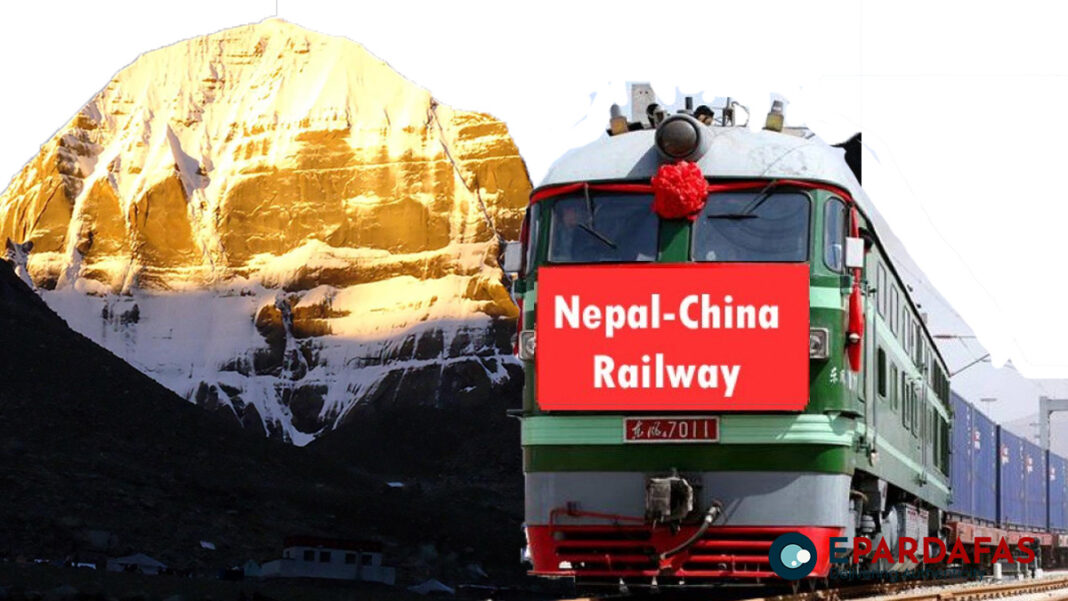The two recent developments in perspective of Nepal-China relations have unfolded the paradigm of egomaniacal Chinese approach towards Nepal.
The first is China’s decision to increase ‘Grass Damage Charge’ for Nepalese workers and porters hired in the Kailash Mansarovar Yatra. And the second is the arrival of a Chinese team in the field for detailed study of Kathmandu-Kerung Railway, which is bound to disturb the equilibrium of the Himalayas.
China is consciously masking its intentions by complicating various provisions of Kailash Mansarovar Yatra, even not sparing the pauper, who wait the entire year for this season to earn the bare minimum. Increasing the grass damage charges from $100 to $300 for Nepalese porters and workers is ridiculous and disheartening. On one hand, China showed its concern to save grass in its land on the other side, not hesitating to tear apart the head-crown of Nepal i.e., the Himalayas.
China once again is pushing the long-awaited Kathmandu-Kerung Railway project in the illusion of an uncertain progress in Nepal. The proposed rail network will connect Nepal’s capital city, Kathmandu, to the Chinese border at Kerung. A 72 km long rail line will be constructed on the Nepalese side crossing the mountainous terrain of the Himalayas. A section of Nepalese is hopeful that it will provide a faster and more efficient mode of transportation, and also provide an alternative route for Nepal’s imports and exports, reducing the country’s dependence on India.
The million-dollar question still exists: will China be capable of constructing railway lines in the Himalayas? Construction of the Qinghai-Tibet railway, which is the highest railway in the world and runs through the Tibetan Plateau, assigns the trust of Nepal to China that it can construct the same. However, constructing railway lines in the Himalayas poses a distinctive combination of challenges, including geological instability, difficult terrain, and adverse weather conditions.
Unlike the Tibet Plateau, the Himalayas are highly seismic and prone to hazards including earthquakes, landslides, floods, drought and other natural disasters. According to data from the Nepal Earthquake Monitoring and Research Centre (Department of Mines and Geology, Govt. of Nepal), there have been 1046 earthquakes (ranging from 4 to 8.1 on the Richter scale) in Nepal from January 2000 to May 2023. The important fact is that an earthquake measuring between 4-5 on the Richter scale can cause moderate damage to buildings and structures, depending on their quality and design of construction and place.
In topographically and environmentally sensitive areas road-rail connectivity projects should not be carried forward simply on the basis of economic feasibility, but their environmental impacts should also be kept into consideration.

The ambitious Chinese projects in Nepal might have serious environmental impacts. Foremost is the threat of earthquakes which Nepal most recently faced in 2015. As per geological studies, the Himalayas are the result of the mountain building caused by the ongoing collision of the Indian plate with the Eurasian plate. This ongoing process of collision makes the entire region highly vulnerable to earthquakes. Hence from a geological perspective, will it be a prudent decision to commission such a big project in such sensitive zones?
The other disruptive factor i.e., landslide usually triggered by intense rainfall upon hilly and unstable slopes in Nepal’s predominantly mountainous terrain.
The proposed section for the railway falls under the Upper Himalayan belt, which receives an annual rainfall of over 3000 mm. In 2022 alone, Nepal’s Disaster Risk Reduction Portal reported 327 landslides across Nepal, causing 99 deaths and adversely affecting 992 families; 19 people went missing, and 88 were injured. Government estimates put economic losses from landslides in 2022 at around NPR 88 million.
The project does not qualify the economic feasibility test. The economic assessment indicates that the project involves hefty investment with high maintenance cost with low returns; going ahead with the project would be beneficial neither to Nepal nor to China in cost benefit analysis.

File Photo
What will be the modalities for maintenance of this railway line once made? When the trade between Nepal and China is not enthusiastic, how will the maintenance factor be taken into account? It has been a quite assimilated phenomenon in Nepal that during monsoon trade from northern borders will be badly disturbed, sometimes for the entire season due to landslides. Even a small disturbance takes weeks in clearing. When there is lack of expertise on the Nepalese side and less willingness from the Chinese side in opening blocked roads due to landslides, how maintenance of railway for the same transportation system can be relied upon?
The Himalayas is a valued global heritage and anthropogenic intervention may disturb its equilibrium. Construction of such a project will not only bruise the physical part of the Himalayas but also its soul i.e. flora and fauna. This ambitious project with no prudence is destined to eradicate thousands of centenarian-aged trees, and vastly damage endangered plants and herbs.
It will disrupt the entire ecological system of the region. The Sagarmatha National Park which has been identified as a protected ecological zone will go through unprecedented damage.
Even though the stated policy of China is against damaging green belts for its projects within the country or overseas, the whimsical pomp and show on boasting of development and infrastructure projects may lead to environmental devastation in violation of China’s own rules- regulations and policy.
Is the rail project a real requirement for Nepal or just another opportunity for political and infrastructural project contractors to make money at the cost of the country’s interests and Chinese strategy to push Nepal in debt trap to eventually have control over the northern part of Nepal to safeguard its Tibetan concerns?
It is well understood that China has an ideology of comparing religion with opium, thus, may have no second thought to shatter the Himalayas but can Nepal afford to adopt this philosophy of damaging its centuries-old tradition of worshipping Sagarmatha and let it be destroyed for trivial vested interests? It is a big question and every Nepali has to introspect on it keeping in mind the Chinese stance on grass damage.
english.pardafas.com

